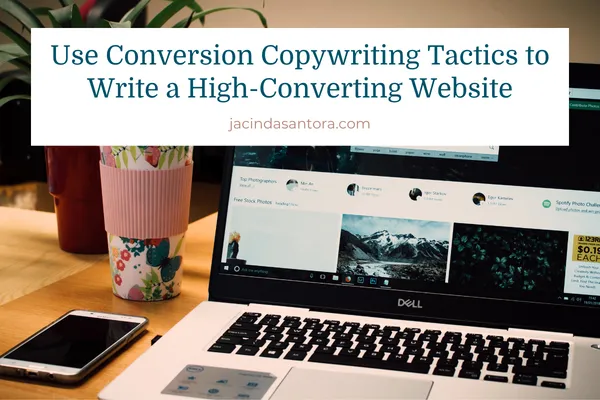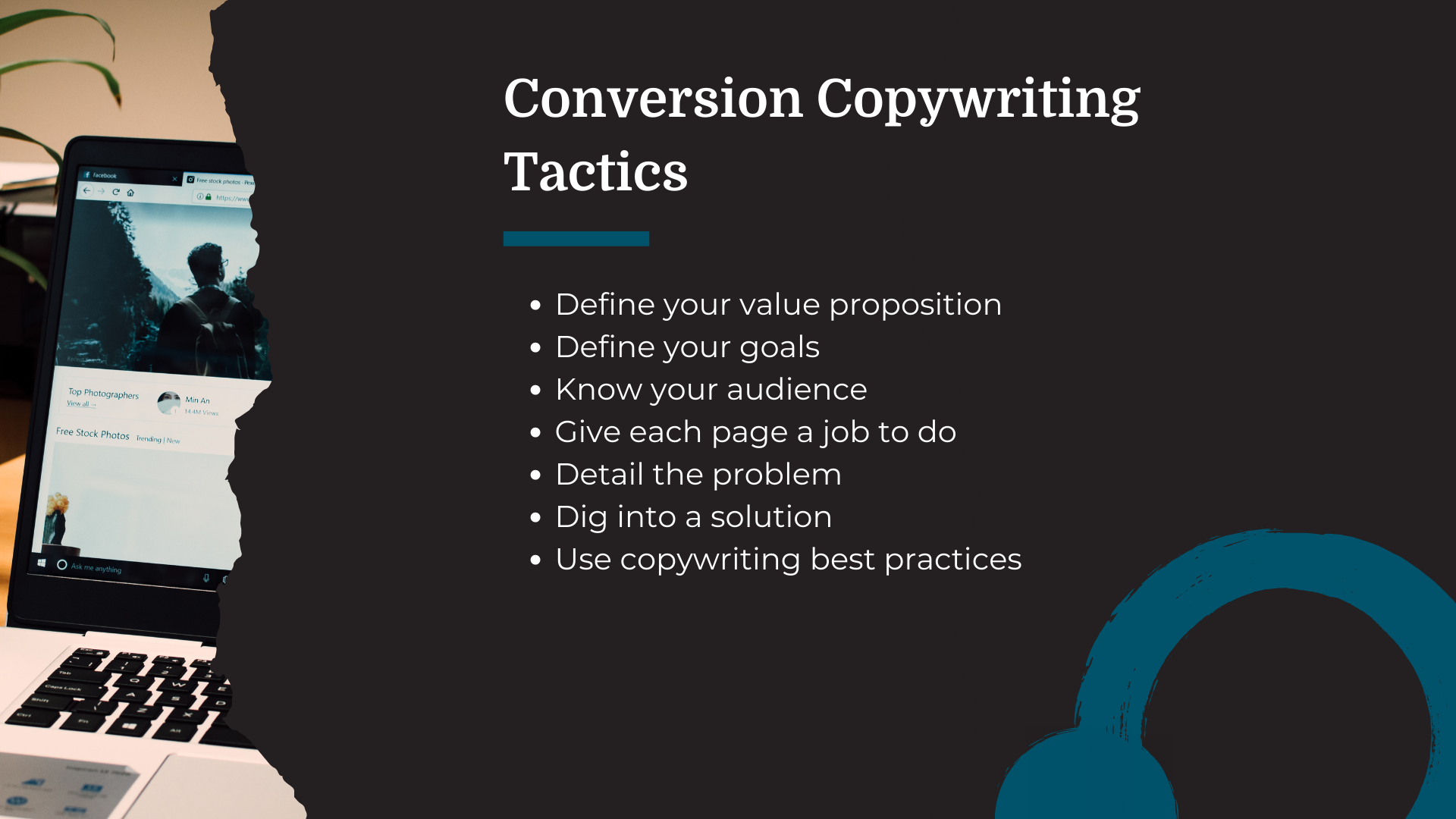



How to Use Conversion Copywriting Tactics to Write a High-Converting Website
You already know that your sales pages need to convert. After all, that’s the entire point of sales pages, isn’t it? What you might not know is that using conversion copywriting tactics on your non-sales pages can have a huge impact on nurturing site visitors.
Many folks don’t realize that your website can act, and should be treated as, a sales funnel.
Visitors can enter this funnel in multiple places — your home page, a particular blog post — but for most visitors that’s where their journey ends.
They enter your funnel at a specific page… and then they leave your funnel from that very same page.
Why?
Because they weren’t nurtured. They weren’t told what to do. Your site wasn’t set up to move them deeper into your sales funnel.
But it can be!

SEO gets them to you, a well-designed and well-written website keeps them.
Conversion is something I didn’t quite understand when I started out years ago as a non-marketing content writer.
I wrote lifestyle and political blog posts… I wasn’t selling anything. Why would I care about conversion?
It was something that I’m now sure the content managers I was working with didn’t understand, either. I wrote content in a vacuum and it was published in silos.
People would find the content via search engine. Come in and read it. And then leave.
Because they weren’t given anything else to do.
When I shifted from content writing to content marketing, the fact that “conversion” was more than just a synonym for “sale” became clear. But it wasn’t really until I started studying copywriting that I realized the importance of conversion copywriting tactics even on non-sales pages.
Conversion copy and conversion copywriting tactics are important on every single page of your website. Well… Maybe not your disclaimers or terms of service. But definitely on all of the non-boilerplate pages.
How to Use Conversion Copywriting Tactics on Non-Sales Pages
You already know that writing a website has a lot of moving parts. If you’re here, you’ve probably already tried writing your own pages and aren’t sure why you’re not holding onto the traffic that comes to your site.
So, how do you make them stay? How do you nurture your anonymous visitors to become interested and informed leads (who will then become customers)?
Conversion Copywriting Tactic: Setting Yourself Up for Success
Before you write even a word, here’s the foundation you need to lay:
Define your value proposition. Your value proposition answers the question “why should I buy from you instead of your competitor?” You’ll use variations of it throughout your entire site. I recommend keeping it under 10 words. It’s not an elevator pitch. It’s a simple phrase that embodies the benefit of your brand (or a specific product/service).
Define your goals. What actions do you want visitors to take on your site? It really helps to outline all the micro conversions that happen to lead a visitor from first landing on your site through becoming a customer. Once you have that, you can set goals for those actions. This could be things like signing up for your newsletter, adding a product to a cart, downloading a lead magnet, or even visiting specific pages on your site.
Know your audience. You have to know who your talking to, what they care about, what their pain points are, and how you can help them before you start writing. Voice of customer research is the best way to get to know your audience and identify the words and phrases they use so you can use those, too.
Conversion Copywriting Tactic: Give Each Page a Job to Do
Once you have that foundation built, it’s time to dig deeper by matching each page to the purpose they serve (the micro conversion you’re looking for).
Take the time to outline your website and give each page a job to do. So, your homepage’s job might be to explain what you do and who it’s for. Product pages share the most important information a visitor needs to decide whether or not they’re going to buy. Blog posts should lead to product pages, sales pages, lead magnet offers, etc, depending on the specific purpose of the blog post.
Don’t outline every single page in-depth. Just keep a sitemap and note each page’s purpose.
Related Content: Ethical Sales Copy: What It Is & How to Do It
Conversion Copywriting Tactic: Detail the Problem
Starting with your value proposition, write down what the problem is that you solve. Next, brainstorm everything you can about the problem that you solve.
If you’ve ever worked with a copywriter, you’ll have heard the question “so what?” And that’s your next step.
Once you have all the ideas down about the problem you solve, go through each of them and ask yourself “so what?” What you’re trying to get to is the why. Why does this problem matter for your audience? Why they should care? What are your reader’s motives?
Conversion Copywriting Tactic: Dig Into the Solution
Once the term “so what?” no longer has meaning, you’re ready to get into the the how (and start asking “so what?” all over again). How will you get the reader from where they are now to where they want to be?
Many people focus on the features of their product or service when writing about how they do what they do.
This isn’t enough.
There are a few different layers to your solution.
Features: A fact about what your product or service is or does.
Advantages: What you can do with that feature.
Benefits: How your life gets better because of that feature.
Features and advantages sound cool, but your readers want to know how your product or service is going to change their lives. They want the benefits (and each feature can have multiple benefits).
There are four different types of benefits to consider:
Functional benefits: The practical outcome of the feature. The hole in the wall (not the drill that put it there).
Financial benefits: Money saved or gained because of the feature.
Experiential benefits: How does the feature make people feel?
Psychosocial benefits: How does the feature make people feel as a person?
Conversion Copywriting Tactic: Write Each Page Using Copywriting Best Practices
It’s time to write!!! Are you excited?
By now, you have a ton of information. Now you get to put it together into a cohesive message that leads the visitors on each page from landing on the page to taking the step you want them to take. Here are some things to keep in mind when putting your research together.
Write Great Headlines
Most people are going to see your headlines and probably not much else. Sad, but true.
To keep your readers interested, your headlines should:
Focus on benefits (which you should know backwards and forwards at this point)
Be direct and simple
Include social proof or data
Offer a time-specific benefit
Want to create amazing headlines? Check out how to write headlines that keep people reading.
Educate Your Readers
SEO is important for getting your pages found on search engines, but all of your copy or content should focus on providing value for your human readers. Write for people, not search engines.
Why is it so important?
You want your readers to become confident in your expertise. This gives you more authority in your space and also inspires trust. And people buy from people they trust.
Communicate Your Value
Along with educating your site’s visitors, your copy should communicate your value, provide what readers need to know to get them to take the action you want, and do it all without making YOU the star of the show.
Add Social Proof
Social proof is a compelling addition to any page on your website. When your visitors are able to hear from or read what other happy customers have to say about you, it increases trust in your brand, products, and services.
Plus, humans are pack animals. We love doing what other humans are doing.
Include Calls to Action
Always, always, always include a call to action. On every single page. What do you want your visitors to that page to do? Tell them to do it!
What’s keeping you from creating a high-converting website for your brand?
If you’re spending time and money driving traffic to your site only to watch them consume your content and leave, it’s time to use some of the conversion copywriting tactics I’ve mentioned here. And be sure to check out these website copywriting dos and don’ts for even more tips!
But here’s the thing…
You’ve got a business to run. You need website copy, but do you really need to be the one writing it?
No.
Let’s talk about what you need. I can get your website into shape and help you lay a solid foundation for your offers while you focus on the things you’re best at.
Nothing in on this page or any other site or communication by or from me is a promise of earnings or guarantee of results.
